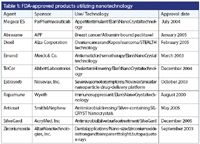What do the applications of nanotechnology mean to pharmacists?
Nanotechnology is in its infancy, but will revolutionize how we develop and deliver drugs in the near future.
You may have heard the buzz. Nanotechnology is going to revolutionize the world. In almost every category of products available, there is a way in which the unique properties and behavior of these tiny particles will help improve our lives: Paint that changes color based on the viewing angle, contact lenses that let you check your blood glucose by simply looking in a mirror, and bendable electronic newspapers with headlines that change as news breaks. Sound futuristic? Well, most of these things are in development or already exist and may soon be available commercially.
For pharmacists, the applications of nanotechnology will mean drugs containing nano-sized active ingredients, breakthrough drug delivery systems that allow deposition of medications in previously inaccessible areas of the body, and improved diagnostic tests and medical devices. But with the advances comes concern. The science behind nanotechnology is still in its infancy. Regulatory agencies are struggling with how to handle the potential risks involved with products that contain these super-small particles.
According to the National Nanotechnology Initiative (NNI), nanotechnology refers to the study of structures that are about 100 nanometers or less. A nanometer is one-billionth of a meter in size and as small as 1/100,000th the diameter of a human hair. When things get this tiny, scientists say, their physics change. As particle size is decreased, the ratio of surface atoms or molecules to the total number increases dramatically. That means materials have greater surface areas which increases their surface reactivity and produces changes in their electrical, magnetic, optical, and biological properties. It is in this range that unforeseen and unique properties become evident.
So far, we only have a limited understanding of how the nano-world functions, but scientists do know that nanotech particles can be created in two basic ways: one method, often referred to as the "top-down" technique, involves reducing particles from standard materials down to nanometer size. This causes changes in material characteristics. For example, carbon becomes 100 times stronger than steel and aluminum becomes explosive.
Another method to reap nano-sized particles uses the "bottom-up" method, where individual atoms and molecules are put together to form nanomaterials such as spheres or tubes that can be used to generate electricity or transport drugs throughout the body. This method of creation is currently less popular, but some scientists predict it could become the dominant pathway in the future.
Despite the sci-fi sound of even just the word, nanotechnology is already a part of our lives. Some sunscreens on the market contain nanoparticles of zinc oxide and titanium dioxide, which allows the normally white product to be more transparent when applied to the skin. Most manufacturers do not disclose the fact that their sunscreens contain nanoparticles because, as of yet, they are not required to do so. Also there is a question regarding the safety of these small chemicals, a question that many believe is not being answered quickly enough. Although no regulation exists on nanoparticles contained in sunscreens, studies have shown that these two ingredients create free radicals, and even in the smallest amounts can damage tissue.
